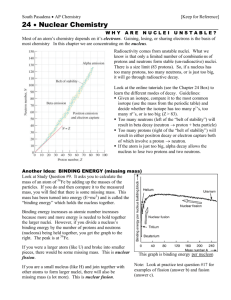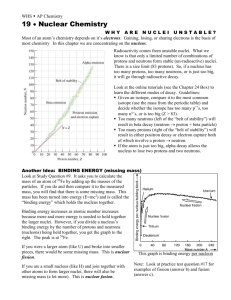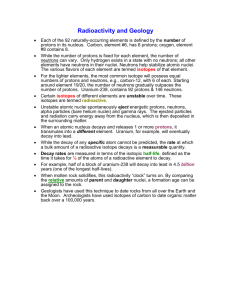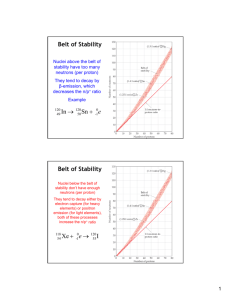NuclearChemistryPPT
advertisement
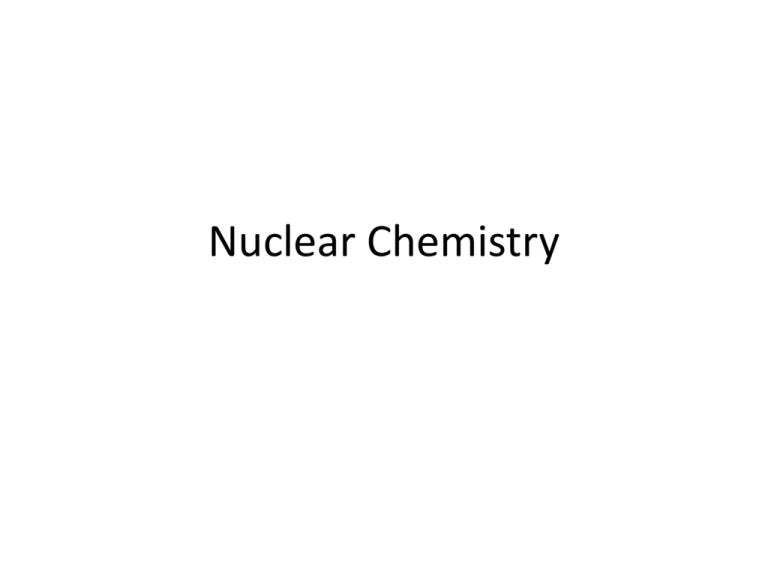
Nuclear Chemistry The Nucleus • Remember that the nucleus is comprised of protons and neutrons. • The number of protons is the atomic number. • The number of protons and neutrons together is the mass of the atom. Isotopes • Not all atoms of the same element have the same mass due to different numbers of neutrons in those atoms. • There are three naturally occurring isotopes of uranium: – Uranium-234 – Uranium-235 – Uranium-238 Stable Nuclei The shaded region in the figure shows what nuclides would be stable, the so-called belt of stability. Most nuclei are stable. It is the ratio of neutrons to protons that determines the stability of a given nucleus. Radioactivity • It is not uncommon for some nuclei to be unstable, or radioactive. • There are no stable nuclei with an atomic number greater than 83. • Radioisotopes = isotopes that are unstable and thus radioactive • There are several ways radionuclides can decay into a different nuclide. Radioactive Series • Large radioactive nuclei cannot stabilize by undergoing only one nuclear transformation. • They undergo a series of decays until they form a stable nuclide (often a nuclide of lead). • Transmutation = the reaction by which the atomic nucleus of one element is changed into the nucleus of a different element Types of Radioactive Decay Alpha Decay = Loss of an -particle (a helium nucleus) 4 2 238 92 U Atomic # increases by 2 # of protons decreases by 2 # of neutrons decreases by 2 Mass # decreases by 4 He 234 90 4 2 Th + He Types of Radioactive Decay Beta Decay = Loss of a -particle (a high energy electron) 0 −1 131 53 Atomic # increases by 1 # of protons increases by 1 # of neutrons decreases by 1 Mass # remains the same I 0 −1 or 131 54 e Xe + 0 −1 e Types of Radioactive Decay Positron Emission = Loss of a positron (a particle that has the same mass as but opposite charge than an electron) 0 1 11 6 Atomic # decreases by 1 # of protons decreases by 1 # of neutrons increases by 1 Mass # remains the same C e 11 5 B + 0 1 e Types of Radioactive Decay Gamma Emission = Loss of a -ray (a photon of high-energy light that has no mass or charge & that almost always accompanies the loss of a nuclear particle) 0 0 Artificial Transmutation = done by bombarding the nucleus with high-energy particles (such as a neutron or alpha particle), causing transmutation 40 96 20Ca + _____ -----> 40 19K + 11H 2 H -----> 1 n + _____ Mo + 42 1 0 **Natural transmutation has a single nucleus undergoing change, while artificial transmutation will have two reactants (fast moving particle & target nuclei.** Nuclear Fission • Nuclear fission is the type of reaction carried out in nuclear reactors. • = splitting of large nuclei into middle weight nuclei and neutrons Nuclear Fission • Bombardment of the radioactive nuclide with a neutron starts the process. • Neutrons released in the transmutation strike other nuclei, causing their decay and the production of more neutrons. • This process continues in what we call a nuclear chain reaction. Nuclear Fusion • = the combining of light nuclei into a heavier nucleus • 2 1H + 21H 42He + energy • Two small, positively-charged nuclei smash together at high temperatures and pressures to form one larger nucleus. Half-Life = the time it takes for half of the atoms in a given sample of an element to decay - Each isotope has its own half-life; the more unstable, the shorter the half-life. - Table T Equations: fraction remaining = (1/2)(t/T) # of half-lives remaining = t/T Key: t = total time elapsed T = half-life Sample Half-Life Question 1A Most chromium atoms are stable, but Cr-51 is an unstable isotope with a half-life of 28 days. (a) What fraction of a sample of Cr-51 will remain after 168 days? Step 1: Determine how many half-lives elapse during 168 days. Step 2: Calculate the fraction remaining. Sample Half-Life Question 1B (b) If a sample of Cr-51 has an original mass of 52.0g, what mass will remain after 168 days? Step 1: Calculate the mass remaining: mass remaining = fraction remaining X original mass (Note: Mass remaining can also be calculated by dividing the current mass by 2 at the end of each half-life.) Sample Half-Life Question 2 How much was present originally in a sample of Cr-51 if 0.75g remains after 168 days? Step 1: Determine how many half-lives elapsed during 168 days. Step 2: Multiply the remaining amount by a factor of 2 for each half-life.


